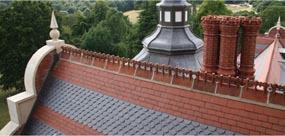Cones and plain clay roof tiles
Conical tower wth plywood skin
 Conical roofs can be covered with layers of thin plywood to a depth of 25mm to maintain a smooth curve.
Conical roofs can be covered with layers of thin plywood to a depth of 25mm to maintain a smooth curve.
The underlay should be laid vertically with vertical laps of 150mm and horizontal laps of 100mm
To comply with the requirements of BS 5534 tiles should be fixed to timber battens. But for heritage and other traditional work, tiles can be fixed directly to the plywood and suitable underlay.
Battens my be scarfed at the back to enable them to be bent around the curvature of the roof. Reefer to the Special Features Techniques for more information on shaping battens. At the apex where the radius is the smallest, it may be necessary to use 4 thicknesses of 6mm timber battens to achieve the flexibility to fit the curve. In this case, the joints of the 6mm curves should be staggered.
Each course is a different width and this will require the tiles to be tapered to maintain the bond of sidelap. For example, a typical conical roof of 70 degree pitch may require 3 sizes of tapered tile; the first of 150mm width at the tail, the second of 125mm and the third of 100mm.
To maintain an effective bond or sidelap with the adjacent courses, the minimum possible width of tile is 81mm. It may be necessary to redrill appropriate nail holes onsite for fixing. Depending on the radius of the curve, it may not be possible to reply on the nibs for support, therefore each tile should be nailed twice.







-A.jpg)


